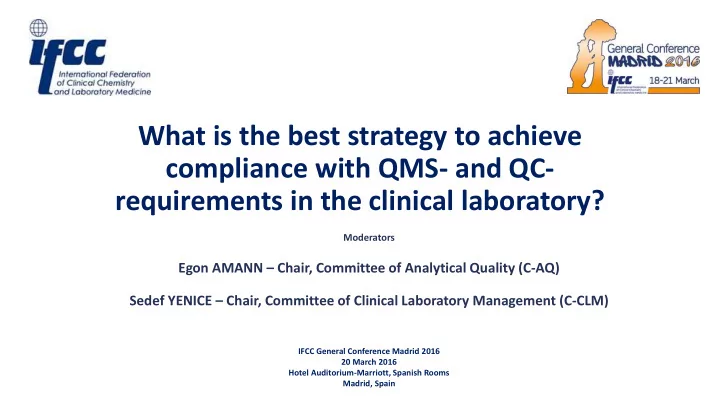

What is the best strategy to achieve compliance with QMS- and QC- requirements in the clinical laboratory? Moderators Egon AMANN – Chair, Committee of Analytical Quality (C-AQ) Sedef YENICE – Chair, Committee of Clinical Laboratory Management (C-CLM) IFCC General Conference Madrid 2016 20 March 2016 Hotel Auditorium-Marriott, Spanish Rooms Madrid, Spain
What is the Goal of this Workshop? • To enhance the participants’ understanding of strategies for dealing with several important aspects of QC before running patient tests and the key steps to establish an effective QMS, • To have the laboratory specialists and technical coworkers more effectively address the problems in implementing continuous quality improvement efforts in the clinical laboratory. 2
Strategy and Schedule TIME PHASE ACTIVITY By (min) 1 5 Opening Moderators Spontaneous group forming – max. 5 or 6 person per group and hand out of a 2 5 Moderators questionnaire to groups Group Discussion. Experimenting with the ideas and finding most burning top Group 3 10 three issues and listing those issues on flip charts by group leaders Members Group Following group discussions, group leaders will present their outcomes for the 15 Leaders entire participants – 3 minutes max. for each group 4 Completion and collection of the questionnaires 10 Moderators Conclusion: Evaluating, deciding, and listing actions
What We’ll Cover Today International Definition Standards Quality Management System ISO 15190:2003 Medical laboratories -- Requirements for safety (QMS) ISO/IEC General requirements for the competence of testing 17025:2005 and calibration laboratories • Stepwise plan for implementing a ISO 22870:2006 Point-of-care testing (POCT) -- Requirements for QMS quality and competence • To implement the QMS in a logical ISO/TS Medical laboratories -- Reduction of error through risk way, the activities are divided over 4 22367:2008 management and continual improvement phases (or stages) of implementation, ISO 15189:2012 Medical laboratories -- Requirements for quality and with each phase having a specific competence focus. CLSI CLSI in US developed the quality management framework and organized the topics as the "12 Quality The requirements in each phase are System Essentials" based on both ISO 15189 and CLSI defined by international standards. GP26-A3 documents SLIPTA Stepwise Laboratory Quality Improvement Process Towards Accreditation implemented by ASLM in Africa
Quality Management System (QMS) Indispensable Elements Organization and Management CONTINOUS RESOURCES PROCESS IMPROVEMENT PERSONNEL DOCUMENTS ASSESSMENT AND RECORDS EQUIPMENT PROCESS NONCONFORMITY PURCHASING MANAGEMENT MANAGEMENT AND INVENTORY INFORMATION FACILITY AND CONTINUAL IMPROVEMENT MANAGEMENT SAFETY Customer Focus http://www.selectscience.net/ The Core - Primary Laboratory Process consists of 3 stages Pre-Analytical Analytical Post-Analytical Sample Sample Sample Sample Sample Sample Sample Recording Reporting Storage of Sample Disposal Request Collection Transport Preparation Processing Registration Examination of Results of Results Sample Reception of Sample
Logical structure to the process of implementing the QMS By WHO, CDC, CLSI QMS affects each single process of lab and consists of Create continuous improvement several layers and prepare for accreditation Ensuring proper management, leadership and organization Controlling and assuring quality and creating traceability Ensuring that the primary process of the laboratory operates correctly and safely The basis of the pyramid consist of inspection https://www.who.int/lqsi/
To implement the QMS in a logical way, the activities are divided over four phases of implementation, with each phase having a specific focus. The Stepwise plan is constructed such that, even when a laboratory does not reach full implementation of the QMS, it has already improved its quality service provision from Phase 1, and as such has benefited already. Ensuring that the Controlling and assuring Create continuous Stepwise plan for implementing a primary process of the Ensuring proper management, quality and creating improvement and prepare Quality Management System laboratory operates leadership and organization traceability for accreditation correctly and safely # QUALITY SYSTEM ESSENTIALS PHASE 1 PHASE 2 PHASE 3 PHASE 4 1 Facilities and Safety Upgrading laboratory biosafety Hazardous Materials Retention schedule for storing materials NONE Quality Management and Quality Development of a quality manual, Quality Compliance of required elements 2 Organization Leadership Project Team Year Plan, Budget planning defined in the SOP Replacement matrix, Potential conflicts of Job description, Training of staff 3 Personnel Competency Assessment Continous Education Program members interest among laboratory staff 4 Equipment Equipment register, SOP Equipment maintenance system NONE Validation of equipment Selection and evaluation of suppliers, 5 Purchasing and Inventory Stock inventory register Adequate stock and ordering system NONE referral laboratories, contracts SOPs for all the tests routinely Validation of methods and equipment, 6 Process Control Sample Management Quality indicators performed IQC activities, TAT, CAPA 7 Documents and Records Master SOP Document control system NONE NONE 8 Information Management NONE Information management system Archive for Laboratory Records NONE Biological Reference Intervals, Decision 9 Customer Service/Focus NONE Client satisfaction survey Communication with clients values IQC, QC for Quantitative, Qualitative & 10 Assessment NONE Setting up an internal audit system External Audit, Action plans SemiQuant. procedures 11 Occurrence (Nonconformity) Management NONE NONE NONE SOP for handling complaints FMEA for proactive risk 12 Continous Improvement NONE NONE NONE management
Quality Management Systems für Laboratories e.g. ISO 15189 Quality Policy Quality Assurance All actions designed to ensure the quality of diagnostic results Other aspects of good Quality Control laboratory practice Internal External quality control quality control
Am Amann E. E. Qu Quality as assu surance in in med edical al lab laboratories. . Paths s to o glo global com ompetence stan andards. . www.q .q-more.com/en/ | | q&m q&more 01 01.15 .15
Steps to adopt any voluntary QM standard 1) Read the document – e.g. ISO ISO 15189:2012 or any standards 2) Does it meet your needs? – Time, Effort, Energy, Money 3) Perform a Gap Analysis 4) Prepare the Laboratory – Information, Education, Guidance, Culture 5) Develop an implementation plan – Gantt Chart your plan 6) Repeat the Gap Analysis 7) Determine your state of readiness 8) Make the accreditation decision – Do you want quality or accreditation or both? 9) Commit to the standard – 1st Achievement, 2nd Accomplishment
Questions and Answers
Recommend
More recommend